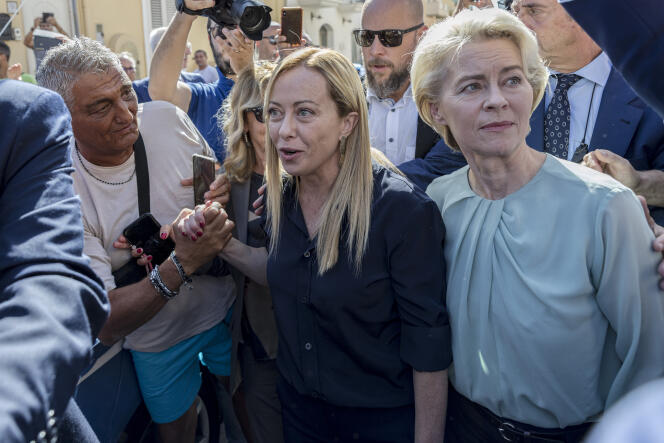


A tiny corner of a tiny island, a remote site that has captured the attention of the whole of Europe in the space of a few days. It has a dirt floor, prefabricated buildings, the shade of a few pine trees and a grey metal gate. Behind it, surrounded by police, military and aid workers, dozens of young people in tattered clothes and exhausted faces waited, seated on the ground in parallel rows.
They would soon be transported further along the road of exile. With their five-digit serial numbers and barcodes hanging from their necks or held in their hands, they were among the tens of thousands of people, mostly from sub-Saharan Africa, who had set foot on Lampedusa since Monday, September 11, reaching Europe thanks to a few days of good weather on the 150 kilometers of sea that separate the island from the Tunisian coast.
The reception center run by the Italian Red Cross – the "Lampedusa hotspot" – where they are among the last waiting to be evacuated, was overwhelmed on Wednesday by these massive-scale arrivals. The site was designed to house 600 people, but its staff had to do their utmost to assist 10 times that number in very tense conditions.
The resulting scenes of chaos were broadcast across Europe and, from Rome to Berlin via Brussels and Paris, opened a continental political debate on the migration issue. On Sunday morning, this culminated in a visit to Lampedusa by European Commission President von der Leyen and Italian Prime Minister Meloni. By visiting the reception center and meeting its managers, the two leaders were able to breathe the same air as some of the migrants who populate their speeches.
Von der Leyen, accompanied by Home Affairs Commissioner Ylva Johansson, arrived at the island's airport, where masses of tourists continue to flock to take advantage of the summer that is stretching out on Europe's southernmost tip, to mark the end of this latest crisis, following months of tension on the island.

With its 7,000 inhabitants, Lampedusa has been a gateway to Europe for three decades. This year, the island has once again become the stopover for the majority of migrants from the African continent, as a result of the intensification of flows on the Tunisian route. More than 128,600 migrants have arrived in Italy since January 1, almost twice as many as the same time last year.
"Irregular migration is a European challenge and it needs a European answer," von der Leyen declared. Alongside Meloni, who she has forged an ongoing relationship with on migration issues, the Commission president unveiled a 10-point plan designed to show that Europe stands by Rome.
You have 64.43% of this article left to read. The rest is for subscribers only.
